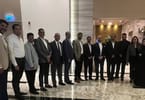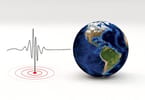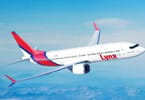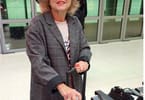THE HAGUE, Netherlands – The Netherlands announced Wednesday it will immediately begin using full body scanners for flights heading to the United States, saying that could have stopped the attempted Christmas Day airline bombing.
The U.S. had not wanted these scanners to be used previously because of privacy concerns but now the Obama administration has agreed that “all possible measures will be used on flights to the U.S.,” Dutch Interior Minister Guusje Ter Horst told a news conference.
Umar Farouk Abdulmutallab boarded Northwest Airlines Flight 253 to Detroit from Amsterdam’s Schiphol Airport on Friday carrying undetected explosives, law enforcement authorities said, adding that 23-year-old Nigerian tried but failed to blow up the plane carrying 289 people.
“It is not exaggerating to say the world has escaped a disaster,” Ter Horst said, calling the situation a “professional” al-Qaida terror attack.
Amsterdam’s Schiphol has 15 body scanners, each costing more than $200,000. But until now neither the European Union nor the U.S. have approved the routine use of the scanners at European airports.
A key European legislator urged the European Union to begin rapidly installing the new equipment across the 27-nation bloc, but no other European nations immediately followed the Dutch move.
Body scanners that peer underneath clothing have been available for years, but privacy advocates say they are a “virtual strip search” because they display an image of the body onto a computer screen.
Ian Dowty, a lawyer with Action on Rights of the Child, said allowing minors to pass through the scanners violates child pornography laws.
“It shows genitalia,” he told The Associated Press. “As far as English law is concerned … it’s unlawful if it’s indecent.”
For that reason, British authorities have exempted under-18s from body scan trials at places including Paddington Station in London as well as Heathrow and Manchester airports.
New software, however, eliminates that problem by projecting a stylized image rather than an actual picture onto a computer screen, highlighting the area of the body where objects are concealed in pockets or under the clothing.
Ter Horst said the scanners likely would have alerted security guards to the materials concealed in Abdulmutallab’s underwear and prevented him from boarding the Northwest flight.
“Our view now is that the use of millimeter wave scanners would certainly have helped detect that he had something on his body, but you can never give 100 percent guarantees,” she said.
At least two scanners in Amsterdam have been experimentally using the less-invasive software since late November and the Dutch said those will be put into use immediately. All other scanners will be upgraded within three weeks.
But the 15 scanners will not cover the 25-30 flights a day that leave Amsterdam for U.S. destinations, and passengers at gates without one will be patted down. Schiphol is waiting for a government directive on whether to buy more machines, airport spokeswoman Kathelijn Vermeulen said.
Homeland Security Secretary Janet Napolitano was briefed Tuesday by the Dutch justice minister on the subject, agency spokeswoman Amy Kudwa said in Washington.
“Schiphol Airport does not need the United States’ permission to screen above and beyond ICAO standards. We of course support advanced imaging technology, as we use it here,” she said in a statement.
In the preliminary report issued Wednesday, the Dutch government called the plan to blow up the Detroit-bound aircraft “professional” but said its execution was “amateurish.”
Ter Horst said Abdulmutallab apparently assembled the explosive device, including 80 grams of Pentrite, or PETN, in the aircraft toilet, then planned to detonate it with a syringe of chemicals. She said the explosives appeared to have been professionally prepared and had been given to Abdulmutallab, but did not elaborate.
“The approach in this case shows — despite the failure of the attack — a fairly professional approach,” the investigation summary stated. “Pentrite is a very powerful conventional explosive, which is not easy to produce yourself.”
“If you want to detonate it, you have to do that another way than he did. That is why we talk about amateurism,” Ter Horst said.
Abdulmutallab arrived in Amsterdam on Friday from Lagos, Nigeria on a KLM flight. After a layover of less than three hours in the international departure hall, he passed through a security check at the gate in Amsterdam, including a hand baggage scan and a metal detector, and boarded the Northwest flight. He did not pass through a full-body scanner.
Abdulmutallab was carrying a valid Nigerian passport and had a valid U.S. visa, the Dutch said. His name also did not appear on any Dutch list of terror suspects.
“No suspicious matters which would give reason to classify the person involved as a high-risk passenger were identified during the security check,” Ter Horst said.
Erik Ackerboom, head of the Dutch counterterrorism bureau, dismissed suggestions that Abdulmutallab should have aroused suspicion when he paid for a round-trip ticket from Lagos to Detroit in cash and had no check-in luggage.
Paying cash in Africa is not unusual, he said, and the lack of a checked suitcase “wasn’t a reason for alarm.”
Abdulmutallab, charged with trying to destroy an aircraft, is being held at the federal prison in Milan, Michigan.
In the U.S., 40 full-body scanners are being operated in at least 19 U.S. airports.
Six U.S. airports are using them for primary screenings: Albuquerque, N.M.; Las Vegas; Miami; San Francisco; Salt Lake City; and Tulsa, Okla. Passengers go through the scans instead of a metal detector, although they can elect to receive a pat-down search from a security officer instead.
The rest of the machines are being used at 13 U.S. airports for secondary screenings of passengers who set off a metal detector. But those travelers can also opt for a pat-down instead.
Later Wednesday, Nigeria echoed the Dutch move, with Civil Aviation Authority chief Harold Demuren in Lagos saying his agency would buy full body scanners and hope to begin installing them next year.
Those comments conflicted with a 2009 report from the U.S. State Department, which said the Nigerian government had approved the installation of U.S.-funded body scanners in all four of Nigeria’s international airports earlier this year.
The reports could not be immediately reconciled.
President Barack Obama has demanded a preliminary report by Thursday from U.S. security authorities on what went wrong in the Detroit airliner case. Obama said the intelligence community should have been able to piece together information that would have raised “red flags” and possibly prevented Abdulmutallab from boarding the airliner.
“There was a mix of human and systemic failures that contributed to this potential catastrophic breach of security,” Obama said Tuesday in Hawaii, calling the intelligence shortcomings “totally unacceptable.”
Abdulmutallab had been placed in one expansive database, but he never made it onto more restrictive lists that would have caught the attention of U.S. counterterrorist screeners, despite his father’s warnings to U.S. Embassy officials in Nigeria last month. Those warnings also did not result in Abdulmutallab’s U.S. visa being revoked.
Last year the European Parliament overwhelmingly voted against using the scanners and called for further study, allowing Schiphol to conduct a pilot test of the scanners.
But opposition faded Wednesday when Peter van Dalen, vice-chairman of the EU assembly’s transport committee, said a recent demonstration at Schiphol showed the equipment did not violate passengers’ privacy.
Still, a Dutch digital rights group, Bits of Freedom, called the decision a fear-driven overreaction.
“The chance of someone being a victim of a terrorist attack in the air is a lot smaller than the chance of being struck by lightning,” the group wrote in an open letter to the Dutch Justice Ministry.
Philip Baum, editor of Aviation Security International, said scanners will still not catch material carried internally, a common smuggling method for drug traffickers.
“Once again, we’re looking for a quick-fix piece of technology when we ought be using the best piece of technology there is — the human brain,” he said. “We ought to be profiling people.”
Meanwhile, officials said on Wednesday that a man tried to board a commercial airliner in the Somali capital of Mogadishu last month carrying powdered chemicals, liquid and a syringe in a case bearing chilling similarities to the Detroit airliner plot.
The Somali man — whose name has not yet been released — was arrested by African Union peacekeeping troops before the Nov. 13 Daallo Airlines flight took off. It had been scheduled to travel from Mogadishu to the northern Somali city of Hargeisa, then to Djibouti and Dubai. A Somali police spokesman, Abdulahi Hassan Barise, said the suspect is in Somali custody.
“We don’t know whether he’s linked with al-Qaida or other foreign organizations, but his actions were the acts of a terrorist. We caught him red-handed,” said Barise.
U.S. investigators said Abdulmutallab told them he received training and instructions from al-Qaida operatives in Yemen, which lies across the Gulf of Aden from Somalia.
WHAT TO TAKE AWAY FROM THIS ARTICLE:
- New software, however, eliminates that problem by projecting a stylized image rather than an actual picture onto a computer screen, highlighting the area of the body where objects are concealed in pockets or under the clothing.
- After a layover of less than three hours in the international departure hall, he passed through a security check at the gate in Amsterdam,….
- Ter Horst said Abdulmutallab apparently assembled the explosive device, including 80 grams of Pentrite, or PETN, in the aircraft toilet, then planned to detonate it with a syringe of chemicals.






















